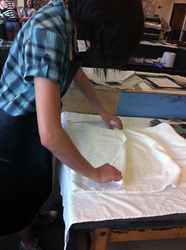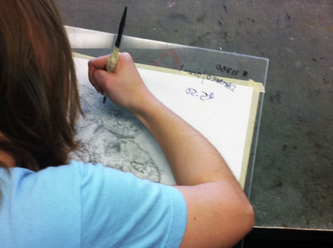Since Fall 2012 I am teaching at West Liberty University, WV Professor of Art.
Teaching Philosophy
I use art practice to challenge my students to think, ask questions, be courageous and responsible. The following are guiding principles that characterize my teaching:
Discussion
I expect my students to use an open dialogue between their work and the work of their classmates. The student should know in which direction the work is going and what goal he/she is trying to accomplish, technically, conceptually or both. This discourse enables students to realize how effectively their ideas have been conveyed, and how well they have understood their own goals. The skill to express and articulate oneself is at the core of studio art practice.
Observation
I aspire to teach students to think about what they see and emphasize the importance of effort and self-discipline as essentials of the learning process. Through systematic and diligent work, a beginning student can learn to observe and, in time, analyze any perceptual challenge.
Motivation
I challenge students to think beyond mere techniques, to give attention to the content and reason behind their artwork, the quest for learning and the drive to expand their perspective beyond the classroom is instilled.
Significance
The process of making, experiencing, and understanding art is closely tied to our personal and social knowledge. Art practice is not only a part of art history, but also of our collective human experience. By focusing on broad ideas about cultural history, religion, politics in literature, film, poetry, I encourage students to see visual art practice as part of a larger framework.
Teaching Philosophy
I use art practice to challenge my students to think, ask questions, be courageous and responsible. The following are guiding principles that characterize my teaching:
Discussion
I expect my students to use an open dialogue between their work and the work of their classmates. The student should know in which direction the work is going and what goal he/she is trying to accomplish, technically, conceptually or both. This discourse enables students to realize how effectively their ideas have been conveyed, and how well they have understood their own goals. The skill to express and articulate oneself is at the core of studio art practice.
Observation
I aspire to teach students to think about what they see and emphasize the importance of effort and self-discipline as essentials of the learning process. Through systematic and diligent work, a beginning student can learn to observe and, in time, analyze any perceptual challenge.
Motivation
I challenge students to think beyond mere techniques, to give attention to the content and reason behind their artwork, the quest for learning and the drive to expand their perspective beyond the classroom is instilled.
Significance
The process of making, experiencing, and understanding art is closely tied to our personal and social knowledge. Art practice is not only a part of art history, but also of our collective human experience. By focusing on broad ideas about cultural history, religion, politics in literature, film, poetry, I encourage students to see visual art practice as part of a larger framework.
















